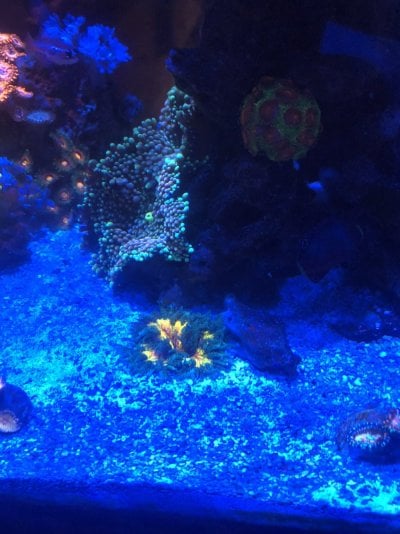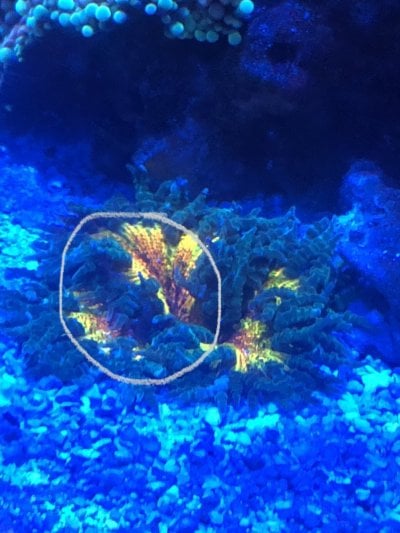Navigation
Install the app
How to install the app on iOS
Follow along with the video below to see how to install our site as a web app on your home screen.
Note: This feature may not be available in some browsers.
More options
You are using an out of date browser. It may not display this or other websites correctly.
You should upgrade or use an alternative browser.
You should upgrade or use an alternative browser.
What makes RFAs release zooxanthellae?
- Thread starter SauceyReef
- Start date
- Tagged users None
I swear I have seen photos of people with RFAs and Riccordia right next to each other with no problems. Aren't they collected in the same areas as well? Here is a beautiful pico reef I follow that has a ton of both.
Nice little tank. I love ricordea FL gardens.
And i mentioned ive never seen those two battle but my mushrooms love to turn things into zombies. I dont have RFAs in my tank.
Adding up everyone's opinions, I think it being next to the riccordia shouldn't be a concern for me. I mean those riccordia have been there for near the same amount of time if not longer, and the RFA can always move.
Ahh the worries that come when a tank starts filling in. My maxi mini slightly moved over the night and is now covering half of my utter chaos colony!
Ahh the worries that come when a tank starts filling in. My maxi mini slightly moved over the night and is now covering half of my utter chaos colony!
Well, I have some zoas that my maxi mini moved next to, and it didnt kill them they are open every day now. The zoas pushed around it and open every day even with the nem touching them.Adding up everyone's opinions, I think it being next to the riccordia shouldn't be a concern for me. I mean those riccordia have been there for near the same amount of time if not longer, and the RFA can always move.
Ahh the worries that come when a tank starts filling in. My maxi mini slightly moved over the night and is now covering half of my utter chaos colony!
Awesome! Hopefully that is the case here, and they are just closing as the main colony is not used to being covered/touched. Ive had zoas touching my RFAs and maxi mini for a while. They wont melt each other, but can definitely cause some polyp disturbance possibly just from smothering them from light.Well, I have some zoas that my maxi mini moved next to, and it didnt kill them they are open every day now. The zoas pushed around it and open every day even with the nem touching them.
Them being collected in the same habitat doesn't mean they can safely touch. You can find foxes and pheasants in the same habitat, after all, but them touching isn't safe.
That said, yeah, the nems can move. They shouldn't be in serious danger from most stinging corals, as they can leave.
That said, yeah, the nems can move. They shouldn't be in serious danger from most stinging corals, as they can leave.
This is the first tank Ive gotten to the point where everything is started to grow in. Pretty cool it can take time for them to get comfortable with each other! The complexities of coral/anemone biochemical communication is insane.Yeah they weren’t happy for a while, but they figured it out
You are correct - that probably was not the best assumption. But I do wonder if corals collected from other areas of the world than the anemones (or other corals) are more or less susceptible to stings.Them being collected in the same habitat doesn't mean they can safely touch. You can find foxes and pheasants in the same habitat, after all, but them touching isn't safe.
That said, yeah, the nems can move. They shouldn't be in serious danger from most stinging corals, as they can leave.
As far as I'm aware, susceptibility to stings is mostly based in things like whether the coral has a skeleton to retreat into. Especially given that a lot of corals practice warfare by digesting the other coral; it's darned hard to be resistant to that.
You make a point, but many corals/anemones dont have any skeletons and still love stinging haha. I am sure though that sofites and stony corals have had tens of thousands, hundreds of thousands, or even millions of years of evolution to both sting, and be stung.As far as I'm aware, susceptibility to stings is mostly based in things like whether the coral has a skeleton to retreat into. Especially given that a lot of corals practice warfare by digesting the other coral; it's darned hard to be resistant to that.
The RFA just looks like it was pinching a loaf. From the photos he doesn’t look damaged and isn’t going pale/bleaching from losing zooxanthellae.
A telltale sign an RFA is in trouble is a gaping mouth. Yours looks good to me. If it’s being bothered enough by any other corals, they will simply move. Here’s a photo of an RFA that is in truly rough shape:

As a testament to their resilience, here’s a photo of one of my RFAs that had been getting absolutely nuked by an angry hammer coral for over 6 months. He just wasn’t concerned enough to move and eventually regrew his disk.

A telltale sign an RFA is in trouble is a gaping mouth. Yours looks good to me. If it’s being bothered enough by any other corals, they will simply move. Here’s a photo of an RFA that is in truly rough shape:
As a testament to their resilience, here’s a photo of one of my RFAs that had been getting absolutely nuked by an angry hammer coral for over 6 months. He just wasn’t concerned enough to move and eventually regrew his disk.
Ive actually had RFA's die on me before from just slowly shrinking and running around the tank. No noticeable problems with the mouth. There must be a few ways for them to kick the bucket. I appreciate you chiming in, but a little scared that an RFA would let itself melt to a Euphyllia before deciding to move... I am sorry you are losing that one - it is truly beautiful with the yellow and green.
I meant that the skeleton helps to protect them against stings, if they can pull their flesh into it and retreat from being stung. It's an arms race, which means all parties involved tend to suffer the entire time.You make a point, but many corals/anemones dont have any skeletons and still love stinging haha. I am sure though that sofites and stony corals have had tens of thousands, hundreds of thousands, or even millions of years of evolution to both sting, and be stung.
That still just looks like pooping. They usually shrink up while doing it. It's probably snagging plankton and bits of stray food to eat.
Is it normal for them to poop 2x-3x per week without being target fed ever?
Similar threads
- Replies
- 38
- Views
- 1,339
- Replies
- 7
- Views
- 717
- Replies
- 6
- Views
- 502
- Replies
- 24
- Views
- 4,452






















